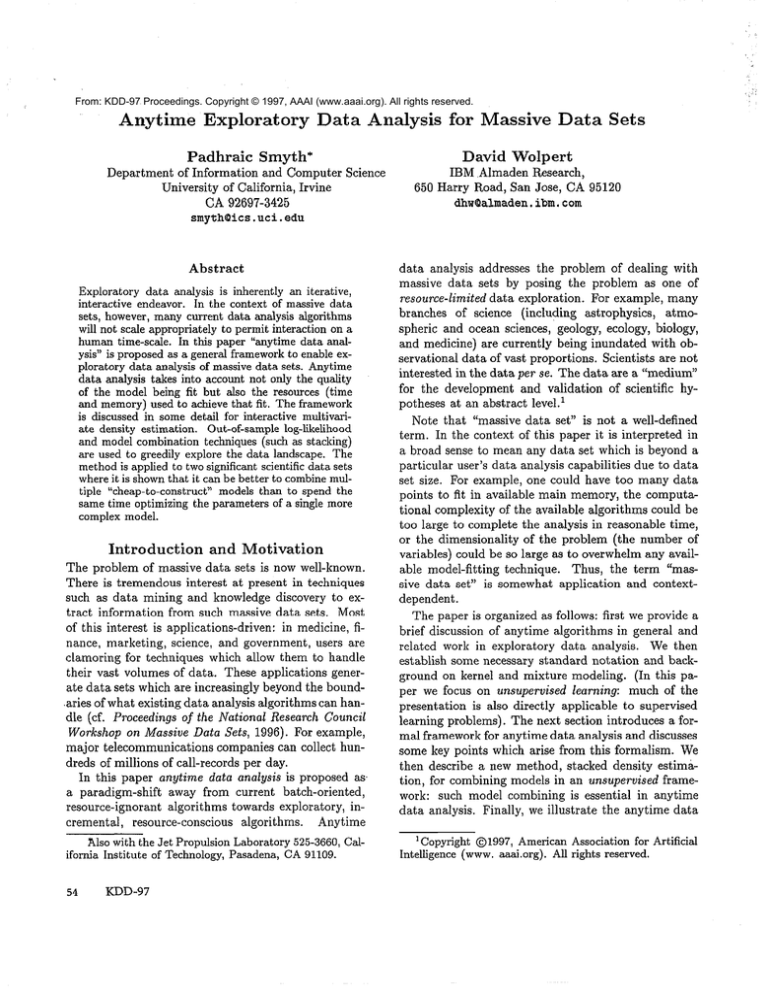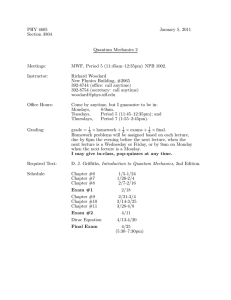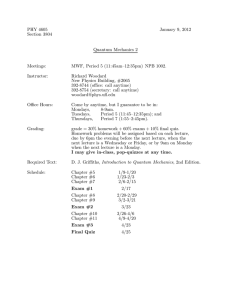
From: KDD-97 Proceedings. Copyright © 1997, AAAI (www.aaai.org). All rights reserved.
Anytime
Exploratory
Padhraic
Data Analysis
Srnyth*
Department of Information and Computer Science
University of California, Irvine
CA 92697-3425
smythQics.uci.edu
Abstract
Exploratory data analysis is inherently an iterative,
interactive endeavor. In the context of massive data
sets, however, many current data analysis algorithms
will not scale appropriately to permit interaction on a
human time-scale. In this paper “anytime data analysis” is proposed as a general framework to enable exploratory data analysis of massive data sets. Anytime
data analysis takes into account not only the quality
of the model being fit but also the resources (time
and memory) used to achieve that fit. The framework
is discussed in some detail for interactive multivariate density estimation. Out-of-sample log-likelihood
and model combination techniques (such as stacking)
are used to greedily explore the data landscape. The
method is applied to two significant scientific data sets
where it is shown that it can be better to combine multiple “cheap-to-construct” models than to spend the
same time optimizing the parameters of a single more
complex model.
Introduction
and Motivation
The problem of massive data sets is now well-known.
There is tremendous interest at present in techniques
such as data mining and knowledge discovery to extract information from such massive data sets. Most
of this interest is applications-driven:
in medicine, finance, marketing, science, and government, users are
clamoring for techniques which allow them to handle
their vast volumes of data. These applications generate data sets which are increasingly beyond the bound.aries of what existing data analysis algorithms can handle (cf. Proceedings of the iVationa1 Research Council
Workshop on Massive Data Sets, 1996). For example,
major telecommunications companies can collect hundreds of millions of call-records per day.
In this paper anytime data analysis is proposed as
a paradigm-shift
away from current batch-oriented,
resource-ignorant algorithms towards exploratory, inAnytime
cremental, resource-conscious algorithms.
Xlso with the Jet Propulsion Laboratory 525-3660, California Institute of Technology, Pasadena, CA 91109.
54
KDD-97
for Massive
David
Data
Sets
Wolpert
IBM .Almaden Research,
650 Harry Road, San Jose, CA 95120
dhwQalmaden . ibm. corn
data analysis addresses the problem of dealing with
massive data sets by posing the problem as one of
resource-limited data exploration. For example, many
branches of science (including astrophysics, atmospheric and ocean sciences, geology, ecology, biology,
and medicine) are currently being inundated with observational data of vast proportions. Scientists are not
interested in the data per se. The data are a “medium”
for the development and validation of scientific hypotheses at an abstract 1evel.l
Note that “massive data set” is not a well-defined
term. In the context of this paper it is interpreted in
a broad sense to mean any data set which is beyond a
particular user’s data analysis capabilities due to data
set size. For example, one could have too many data
points to fit in available main memory, the computational complexity of the available algorithms could be
too large to complete the analysis in reasonable time,
or the dimensionality of the problem (the number of
variables) could be so large as to overwhelm any available model-fitting technique. Thus, the term “massive data set” is somewhat application and contextdependent.
The paper is organized as follows: first we provide a
brief discussion of anytime algorithms in general and
related work in exploratory data analysis. We then
establish some necessary standard notation and background on kernel and mixture modeling. (In this paper we focus on unsupervised learning: much of the
presentation is also directly applicable to supervised
learning problems). The next section introduces a formal framework for anytime data analysis and discusses
some key points which arise from this formalism. We
then describe a new method, stacked density estimation, for combining models in an unsupervised framework: such model combining is essential in anytime
data analysis. Finally, we illustrate the anytime data
‘Copyright 01997, American Association for Artificial
Intelligence (www. aaai.org). All rights reserved.
analysis framework by proposing some simple static
anytime strategies and investigating their performance
profiies on two iarge data sets.
Related
Work
Exact definitions of anytime algorithms vary with different authors, but in general an anytime algorithm is
an algorithm which produces a set of outputs continuously over time (Zilberstein and Russell, 1996). Thus,
in contrast to conventional algorithms, an anytime algorithm can be interrupted at “any time” and still
produce an output of a certain quality. The foundationai work in this area reiies on a decision-theoretic
framing of the problem, and in particular, the principle of maximum expected utility (Dean and Wellman
(1991), Horvitz (1987), Russell and Wefald (1991)).
Anytime algorithms have largely been developed in the
context of artificial-intelligence approaches to planning
and reasoning. We are not aware of any direct application of anytime algorithms to unsupervised data
analysis to date.
There is a large body of work on online learning
Iwhere
\..-----
t.he
nnints
___- C1a.t.a.
---=------
m,re presumed
to
arrive
se-
quentially in real-time) in the adaptive control, pattern recognition, and signal processing literatures (for
recent work see for example, Moore and Schneider
(1996)). For example, many neural network algorithms
are designed to operate in an online fashion, and many
statistical estimation algorithms can readily be formulated for online adaptation.
However, this work
is mainly concerned with parameter estimation rather
than exploring a family of models and as such do not
provide a general basis for anytime data analysis where
modei structure is unknown a priori. Hatch data anaiysis algorithms which are iterative in nature have a
natural anytime interpretation (i.e., one can always use
the estimates from the most recent iteration). Indeed
we will take advantage of this later in the paper. All
of these methods can be viewed as restricted special
cases of a general anytime data analysis framework.
Notation
and Background
Let : be a particular realization of the d-dimensional
multivariate variable X. We will discuss data sets
where each sample gii, 1 5 i 5 N
D = {:I,. . , ,a},
is an independently drawn sample from an underlying
density function f(g).
A commonly used model for
probabilistic clustering and density estimation is the
finite mixture model with k components, defined as:
f”(ic)= 2 ajSj(4’
j=l
(1)
which consists of a linear combination of k component
distributions with C (Y = 1. The component gj’s are
..-.--,I---1-L: -.-,w. sllllp)lc
2 --,..-:-,.J-,
J:,+,:L..+:,.,, ,..,1,
usually relablvaly
ullllll”ual U15U1UUbI”113
3ULll
as Gaussian distributions. The model can be generalized to include background noise models, outlier models, and so forth. Density estimation with mixtures
involves finding the locations, shapes, and weights of
the component densities from data (using for example
the Expectation-Maximization
(EM) procedure). Kernel density estimation can be viewed as a special case
of mixture modeling where a component is centred at
each data point, given a weight of l/N, and a common
covariance structure (kernel shape) is estimated from
the data.
In terms of time complexity, fitting a Ic component
Gaussian mixture model with arbitrary covariance matrices in d dimensions scales as O(lcNEd2) where E is
the number of iterations of the EM algorithm.
The
scaling of E as a function of d and N is not well understood in general: for some clustering applications it
is sufficient to fix E as a constant (say 50 iterations),
however this by no means guarantees the resulting fit
will be even close to a local maximum of the likelihood
function.
The quality of a particular probabilistic model can
be evaluated by an appropriate scoring rule on independent out-of-sample data such as the test loglikelihood or log-scoring rule. Given a test data set
Dtest, the test likelihood is defined as
logf(DtestIfk(ic))
= c logf”(ai) (2)
An important point is that this log-scoring objective
function is an effective and consistent method for coniparing cluster models and density estimates in an unsupervised learning context, i.e., it plays the role of
classification error in classification or squared error in
regression.
An Anytime
Data Analysis
Framework
We are given a data set D. Dj s D denotes a subset
of the elements of D (e.g., a random sample, a bootstrap sample, etc). We also have a finite set of “unfit,t,&’
mnrleln
*_.---_-
ara.ila.hle.
I. -------,
MU = IMY.
_ _ MCI.
-.I-‘-I 1---,--n,>
which
are indexed by k, i.e., M,J could be a mixture of a
particular type with a particular number of components, or a type of kernel density model, and so forth.
To fit the models we have a set of algorithms availAL}, e.g., the EM procedure for
able, A = {AI,...,
mixtures and various bandwidth-setting algorithms for
kernels. An algorithm Al can be viewed as a mapping
from an instantiation of the tuple < Dj, ki, q, rt > to
a fitted model Ml. The parameter q is a scalar or
Smytb
55
vector influencing
the “quality”
rrnrit.hm
wlrh 2c t,he ~~p&er
o”-’
. . . . . . .....y.-
of the estimation
nf &ps
gr
al-
nu&pr
Qf
random restarts in an EM procedure, or the resolution of the bandwidth search in a kernel estimator. rt
represents in a general sense prior knowledge available
at time t when the algorithm is run, including results
from previous algorithm runs, user-defined constraints,
and so forth.
For computational simplicity, we will restrict our attention to the maximum a posteriori (MAP) estimation
framework where posterior modes are reported rather
than full posterior densities. The generalization to a
full Bayesian analysis in the anytime context is clearly
of interest, but may be computationally impractical,
and is not addressed here.
A strategy S is a particular sequence of algorithms
and algorithm input parameters,
S
=
{Al(Dl,ql,~l,nl),...,
Aj(Dj,qj,bq)...,
AJ(DJ,
qJ, LJ, ‘ITJ)).
The performance profile of a strategy is a plot of utility versus computation time for a particular sequence
of algorithm runs. Finding the optimal solution to the
anytime data analysis problem in this context can be
stated as follows:
Given D, MU, A, and ~1, find a strategy S such
that computational and memory constraints are
obeyed and 5 IS strictiy dominant over aii other
strategies in terms of the performance profile.
There are some general comments worth making at
this point:
It seems very likely that any non-trivial instantiation of finding the best strategy will be NP-hard.
Even in very restricted versions of this problem, such
as choosing between the better of kernel estimators
with different kernel shapes, there is no way to determine the optimal strategy without knowing the
true f(g). Thus, in practice, our attention will be
limited to finding good heuristic (typically myopic)
strategies as has been the practice with anytime algorithms in other problem domains.
l
l
l
56
One can distinguish between static anytime strategies which are determined a priori, and adaptive anytime strategies where the algorithm and parameters
at time t + 1 are chosen adaptively based on results
up to time t.
Static strategies are clearly more limited than adaptive strategies, yet, already they form an interesting
KDD-97
generalization of typical data analysis methods.
t.hin
-_--I context.
--_--I--d,
“&s&&”
nlrmrithmn
1-o ---------I,
such
----_
In
as iters-
tive improvement learning procedures like backpropagation or EM, can be viewed as naive “single-step”
strategies which ignore resource constraints.
Adaptive strategies provide a powerful framework to
adaptively explore data but are faced with great uncertainty in terms of trying to choose the next be&
step at any stage without knowing the true f(g).
Markov-chain Monte Carlo methods, which are currently popular in applied Bayesian statistics, can be
viewed as adaptive strategies which use estimates
of posterior probability densities to guide search in
model space: however, resource constraints are typically ignored and there is no formal connection to
an anytime algorithmic framework.
Unsupervised
Stacking
Combination
for Model
Model combination techniques have been widely used
in regression and classification (e.g., Chan and Stolfo,
1996; Breiman 1996a, 1996b, Wolpert 1992), but relatively rarely in unsupervised learning. However, using
estimated out-of-sample iog-iiMih00d
as the performance metric, it is straightforward to combine different
density models.
Here we consider stacked density estimation which
we briefly review (for details see Smyth and Wolpert,
1997). Consider that we have K individual estimates
for the density of c, nameiy, $‘(aj, . . . , s”(gj.
These
could be kernel estimators with different bandwidths
or shapes, mixture models with different numbers of
components, etc. We would like to combine these f’s
into a single predictive model. The straightforward
approach is to treat the combined model as a mixture
with II components,
(3)
kc1
where the ,i3k are unknown parameters which can be
assumed to be non-negative and sum to 1 in the standard fashion.
In this context; stacked density estimation works as
follows. First one runs v-fold cross-validation on the
training data, and for each fold, train each of the models f”(g) on the training partition and predict each of
the test density points (i.e., calculate the f” @ii) where
LZ~E{ test partition 1). After cross-validation is complete, one has a table of N x K density values, an
out of sample prediction for each of the N data points
for each of the I’ models. The EM procedure can be
used directly on this table to estimate the p weights
Table 1: Performance of stacking multiple mixture
models (using different weighting schemes) on the asteroid data set (described in more detail in the next
section). 1500 data points were used for model-fitting
and stacking. 2000 data points were used to evaluate
the out-of-sample log-likelihood.
Weighting
Method
Best Single Model
Uniform Weighting
Stacking
Out-of-Sample
Log-Likelihood
6333.2
6449.6
6476.6
in the stacked mixture above. Finally the K models
are retrained on all of the training data and weighted
according to the p’s for prediction. An alternative approach in the context of massive data sets is to simply
use a separate validation set to estimate the ,8 weights:
if data are “cheap,” but computation time is “expensive,” this strategy may be more effective than crossvalidation.
The component density models fk can themselves
be mixture models with different numbers of components. This leads to an interesting representation, a
hierarchical “mixture of mixtures” models, providing
a natural multi-scale representation of the data. Each
of the components models a different scale in the data,
i.e., models with fewer mixture components will be
broad in scale, while models with more components
can reflect
ll--e-m-o determines
--A------------_--1 mm-e
___-__ detail.
--1-___ LStnckinc
in a &&a-
adaptive manner which scale is emphasized. More generally, one can mix and match many different types
of density function models: kernel density estimators
with different shapes and bandwidths, mixture models with non-Gaussian components, and Gaussian mixtures with different numbers of components and different covariance structures. For example, a useful combination (which we use later) is to combine finite support kernels (such as triangular kernels) with Gaussian
mixtures: the Gaussian mixtures tend to regularize the
tendency of finite support kerneis to Wow
up” jinfinitely negative log-likelihood) when data points are
outside the support of the model.
Results of a simple experiment with combining
Gaussian mixtures are shown in Table 1. The table
shows the out-of-sample test log-likelihood, where the
test data was not used in any way during training,
for three methods of combining mixture models with
k= 1,2,..., 9,10 components, using the asteroid data.
The first, method “cheats” and looks at the test data
to pick the single best model. The second method uniformly weights the 10 models. The third uses cross-
validated stacking as described originally in Wolpert
(1992) but adapted for density estim&onI the stacking
weights can be quickly estimated by EM (Smyth and
Wolpert, 1997). Both combining methods outperform
the single best model chosen by “cheating” (agreeing
with what Breiman (1996a) found for supervised learning), and stacking outperforms uniform weighting. The
log-likelihood scale is not particularly intuitive, but its
argued by Madigan and Raftery (1994), a difference of
5 or so on this scale effectively means that the posterior
,,,h,h;l:t..
Atha
-_,.a
l:L-al., III”Ux.I
maclc.1 ,y”C”
&man
the
rl.tza ;E
pL”ua”rrr”y
“I YIIb IIIVIL.
rrr,tAg
“ALU ucuuu
.”
an order of magnitude greater.
In experiments on several other data sets we have
found that stacked density estimation consistently produces better density estimates than choosing a single
model using cross-validation, a single model chosen by
looking at the test data, or uniform weighting (Smyth
and Wolpert, 1997). For anytime algorithms such combining methods are critically important since they allow the results of earlier model fitting to be incorporated into current estimates (rather than being discarded).
Anytime
Density
Estimation
In this section we explore a particular set of static anytime strategies and evaluate their performance. These
examples are intended to be illustrative.
A simple utility function is mutual information
w h ic h measures the information between
Whf(d)>
the encoder (the data generating process, f(g)) and
the receiver (the data analyst). It is straightforward
to show that the mean out-of-sampie iog-iikeiihood
l/N c:,
1% f(Eii) is an unbiased estimator of the increase in mutual information (or reduction in uncertainty) about f(g) from knowing f^.
Given the limited space constraints, we briefly discuss four different types of strategies and illustrate
their use on two scientific data sets. The anytime
strategies (in increasing complexity) are:
Mixture:
Fit
a single Gaussian mixture
model with k components and report the parameters
in an anytime fashion at e&ch iteration of EM. Select
the highest-likelihood initialization from 5 different,
initializations of the EM algorithm using k-means.
Single
Best:
Fit a sequence of models in this order: triangular product kernels with bandwidths of
{0.1,0.2,0.5,0.7,1.0,1.5,2.0,3.0}timesthestandard
deviation in each dimension, and Gaussian mixtures
components each with arbiwith k E {2,4,8,16}
trary covariance matrices. In fitting the Gaussian
mixtures, only run the EM algorithm for 10 iterations, and use the “ best, of 5” k-means initialization
Single
Smyth
57
Asteroid Data: Profiles of Anytime Density Estimatton Strategies
. - *. -, ..
2.8
2.35
2.9
2.95
3
3.05
. . *. .* .
3.1
3.15
3.2
3.25
stacking-o-
3.3
unllorm .+.
Figure 1: Portion
details
of asteroid data set: see text for
single best -:
0.1 -
as in 1. Reserve some of the training data as a validation data set and as each new model is constructed
choose the single model which performs best on the
validation data set.
Weights:
The same sequence as for ‘Single
Best,” but combine the models at each step using
uniform weights.
ox::xi
0
mkture (k=4) -
I
i
,
mixture (k=l6) -xI
5
10
15
20
25
30
Cputkne (seconds)
%niform
The same sequence as for “Single
Best,” but combine the models at each step using
stacking weights which are estimated on the validation subset of the training data.
Stacked
Weights:
Figure 1 shows a well-known asteroid data set, where
each data point corresponds to a known asteroid in the
Solar System. The x-axis corresponds to distance from
the Sun in astronomical units (this particular region is
between Mars and Jupiter) and the y-axis is the eccentricity of the orbit of the asteroid. The existence
in such data of gaps and “families of asteroids” (i.e,
clusters) are very much the subject of current debate
in the planetary geology community (Zappala et al,
1995; Lagervist and Barucci, 1992). There are over
30,000 such data points and only a fraction of the data
set is displayed here. This data set is typical in certain
respects of observational science data: a large, continually growing, collection of data which is continually
being analyzed by a variety of scientists interested in
refining their understanding of the underlying structure.
The plots show out-of-sample log-likelihood per sample on the test data set, i.e., an estimate of “information gain” about the unknown density in each case,
58
KDD-97
Star-Galaxy
Data: Profiles of Anytime Density Estimation Stratsgles
a
6-
stacking-cuniform .+,
single best -:
mixture (k=4) --
20
30
Cputime (seconds)
40
50
Figure 2: Profile information plot for (a) the asteroid
data and (b) the star-galaxy data for various simple
static strategies for anytime density estimation combining Gaussian mixture and triangular kernel density
estimates. See text for details.
This information gain is computed in each case relative to a default prior consisting of a single Gaussian
bump fitted to the data.
Figure 2(a) shows the estimated anytime profiles on
the asteroid data with 1000 training data points, of
which 500 are reserved for validation, and 1500 test
data points. Stacking and uniform weighting dominate, and the single model strategies are universally
worse. Note that the model combining strategies dominate the single-model strategies at all times.
Figure 2(b) shows the estimated profiles on an 8 dimensional data set describing stars and galaxies, with
1500 training data points, of which 600 are used for
validation, and 1000 test data points. This is the SKICAT data with the class labels removed (Weir et al.,
1995). Here, astronomers are interested in the existence of subclusters among the galaxies. The data used
here is only a small fraction of what is a data collection with millions of records. Here stacking dominates
all other strategies. Uniform weighting is competitive
with stacking and the single best strategy eventually
finds a model which is competitive with the weighting
---LL-_IA- LLIJ-L- tzb,
-..I. Ll-1. ~ A --!-L--- 1110ue1
---~-I
VII
bIllS
Uaba
IJIlt: R = 4 IIIIXbUIx
IIlebIlwUs.
(and k = 16, not shown, because it is so off-scale) overfit to the extent that the information gain is negative
relative to a single Gaussian.
Generally speaking the plots clearly demonstrate
that searching among multiple models is a much more
effective strategy than fitting a Gaussian mixture
model with some fixed number of components to these
data sets. Furthermore, among the methods which
consider multiple models, the stacking strategy dominated on these data sets and for these models.
These experiments only scratch the surface of the potential possibilities for anytime-type algorithms in exploratory data analysis. For example, for massive data
sets one may want to consider building models on small
subsets of the data and combining them together (e.g.,
Breiman, 1997). In addition, there are clear benefits to
be gained from having adaptive strategies versus static
ones, so that the exploration algorithm can adapt to
the data “landscape” and eliminate low-utility models
which take time to fit but produce negligible information gain.
Conclusions
Tn
ALI thin
“IIA.y n~na,~
y.AybL
,ilrn
_I”U n~nnncm-l
yA”y”uuu
thn
mncmd
“l&U “““cuy”
~nvt;nw
Arat=
“Inf CU’
LJUII11., UIUUU,
analysis as a flexible and practical framework for exploratory analysis of massive data sets. In particular,
we used novel combining schemes based on stacking
which support anytime density estimation and illustrated their utility on two real-world data sets. Anytime data analysis appears well-suited as a framework
‘for tackling the problems which are inherent to massive
data sets.
Acknowledgments
Part of the research described in this paper was carried
out by the Jet Propulsion Laboratory, California Institute of Technology, under a contract with the National
Aeronautics and Space Administration.
References
Breiman, L., ‘Stacked regressions,’ Machine Learning,
24,49-64, 1996a.
Breiman, L., ‘Bagging predictors,’ Machine Learning,
26(2), 123-140, 1996b.
Breiman, L., ‘Pasting bites together for prediction in
large data sets and on-line,’ preprint, 1997.
Chan, P. K., and Stolfo, S. J., ‘Sharing learned models among remote database partitions by local meta
learning,’ in Proceedings of the Second International
Conference on Icnomledge Discovery and Data Mining, Menlo Park, CA: AAAI Press, 2-7.
Dean, T. L., and Wellman, M. P., Planning and
ControE, San Mateo, California: Morgan Kaufmann,
1991.
the
Hansen, E., and Zilberstein, S., ‘Monitoring
progress of anytime problem-solving,’ Proceedings of
the 13th National Conference on Artificial Intelligence, Menlo Park, CA: AAAI Press, 1996.
Horvitz, E., J., ‘Reasoning about beliefs and actions
under computational resource constraints,’ in Proceedings of the 1989 Workshop on Uncertainty and
AI, 1987.
Lagervist, C. I., and Barucci, A., ‘Asteroids: distributions, morphologies, origins, and evolution,’ Surveys
in Geophysics, 13, 165-208, 1992.
Madigan, D., and Raftery, A. E., ‘Model selection and
accounting for model uncertainty in graphical models using Occam’s window,’ J.: Am. Stat. ASSOC.,
1994.
Moore, A. W., and Schneider, J., ‘Memory-based
stochastic optimization,’ in Advances in Neural Information Processing 8, 0. S. ‘Touretzky, M. C.
Mozer, and M. E. Hasselmo (eds.), Cambridge, MA:
MIT Press, 1066-1072, 1996.
Proceedings of the National Research Coerncil Workshop on Massive Data Sets, Washington, DC: National Academy Press, 1996.
Smyth
59
E. W., Do the Right
Thing: Studies in Limited Rationality, Cambridge,
Russell, S. J., and Wefald,
MA: MIT Press, 1991.
Smyth,
P.,‘Clustering
using Monte-Carlo
crossvalidation,’ in Proceedings of the Second International Conferenceon Icnowledge Discovery and Data
Mining, Menlo Park, CA: AAAI Press, pp.126-133,
1996.
Smyth, P., and Wolpert, D., ‘Stacked density estimation,’ preprint, 1997.
Weir, N., Fayyad, U. M., Djorgovski,
mated
----I--
sta.rI~illa.xv
-1-- , o-.--e-d
classificatinn
---Lf___-__.l____
II,’ The Astronomical
Wolpert,
D. 1992.
S. G., ‘Auto-
for
_-_ di&ti7d=d
-_
PoSS-
Journal, 1995. o------
‘Stacked generalization,’
Neural
Networks, 5, 241-259.
Zappala, V., et al., ‘Asteroid
10 nc!v
A&,-t”,
. ...--1,.
acbulplt:
..,:...”
uaq$
+...,.
CW”
families:
A:cF-.,..c
uI1Lcxxx1b
search of a
,l..A.,L,d
L,UiYbc.~lU~
c,.,L.
IruAl-
niques,’ Zcarus, 116, 291-314, 1995.
Zilberstein, S., and Russell, S. J., ‘Optimal composition of real-time systems,’ Artificial Zntelligence,
82( l-2),
181-213,
April 1996.
(.
/
60
KDD-97
,’





